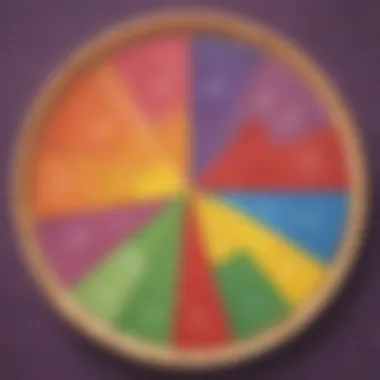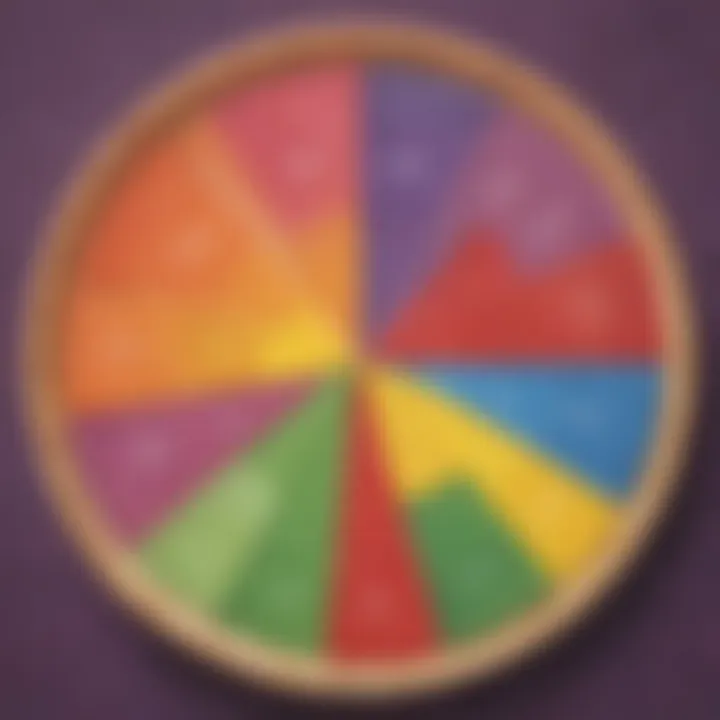Mastering Fractions: A Comprehensive Guide to Solving Fraction Problems


Creative Activities
Fun Quizzes
Test your fraction skills and knowledge with entertaining and enlightening quizzes designed to reinforce learning in an engaging way. Dive into a myriad of quiz topics that cover a wide range of fraction-related concepts, from basic operations to complex problem-solving strategies. These quizzes feature various question types, including multiple choice, true or false, and fill-in-the-blank, ensuring a diverse and stimulating challenge for young learners. By participating in these quizzes, children can reinforce their understanding of fractions while enjoying a fun and interactive learning experience. Discover how these quizzes serve as a valuable tool for knowledge reinforcement, solidifying fractions principles in a compelling and effective manner.
Fact-Based Articles
Delve into a wealth of fact-based articles that elucidate diverse topics within the realm of fractions. Explore engaging content presented in an easy-to-understand manner, making complex fraction concepts accessible to elementary school children, parents, and caregivers. These articles cover a wide spectrum of fraction-related subjects, ranging from foundational principles to advanced techniques, catering to individuals at various stages of their fraction mastery journey. Additionally, access additional resources such as related articles and external links for further exploration, expanding your knowledge and understanding of fractions beyond the confines of this comprehensive guide.
Understanding Fractions
Understanding fractions is crucial in the realm of mathematics. Fractional concepts are fundamental in many mathematical operations, serving as the building blocks for more complex calculations. By comprehending fractions, students can unlock the ability to tackle various mathematical problems with confidence and accuracy. Embracing a solid understanding of fractions paves the way for mastering different mathematical concepts seamlessly and efficiently.
Introduction to Fractions
Definition of Fractions
The Definition of Fractions is a pivotal concept in mathematics as it defines the division of objects or numbers into equal parts. This fundamental concept allows individuals to express quantities that are not whole numbers, enabling a more precise representation of values in mathematical calculations. Understanding the Definition of Fractions is crucial as it forms the basis for numerous mathematical operations, laying the groundwork for advanced problem-solving techniques.
Types of Fractions
The distinction between various types of fractions, such as proper fractions, improper fractions, and mixed numbers, is essential in mastering fractions. Proper fractions represent values less than one, while improper fractions exceed one. Mixed numbers combine whole numbers and proper fractions into a single entity. Grasping the Types of Fractions provides a comprehensive insight into how different fractional forms operate within mathematical contexts, facilitating a deeper understanding of numerical relationships.
Importance of Fractions in Mathematics
Fractions play a vital role in mathematics by enabling precise representations of values that fall between whole numbers. Understanding fractions is not just a foundational skill but a gateway to grasping more advanced mathematical concepts. Proficiency in fractions allows individuals to solve real-world problems, make accurate measurements, and analyze data effectively. Recognizing the Importance of Fractions in Mathematics equips learners with essential skills needed to excel in various academic and practical scenarios.


Numerators and Denominators
Definition and Roles
The fundamental components of fractions, numerators, and denominators dictate the value and magnitude of fractional expressions. The numerator signifies the number of equal parts being considered, while the denominator denotes the total number of parts into which the whole is divided. Mastering the roles of Numerators and Denominators is crucial for accurately interpreting and manipulating fractions in mathematical operations.
Proper vs. Improper Fractions
The distinction between proper and improper fractions lies in the relationship between the numerator and denominator. Proper fractions have numerators smaller than denominators, representing values less than one, whereas improper fractions have numerators equal to or larger than denominators, denoting values greater than one. Understanding the differences between Proper and Improper Fractions is essential for converting between various fractional forms and performing arithmetic operations efficiently.
Conversion between Proper and Improper Fractions
Converting between proper and improper fractions involves transforming fractional expressions from one form to another while maintaining equivalence. This conversion process allows individuals to work with fractions interchangeably, depending on the requirements of specific mathematical problems. Mastering the Conversion between Proper and Improper Fractions enhances flexibility in mathematical calculations and simplifies operations involving mixed numbers or fractional quantities.
Equivalent Fractions
Concept of Equivalency
The concept of equivalent fractions underscores the idea that different fractional representations can convey the same value. Equivalent fractions have different numerators and denominators but equal overall magnitudes. Recognizing the Concept of Equivalency enables individuals to simplify fractions, compare values, and perform operations seamlessly, expanding problem-solving capabilities and enhancing mathematical fluency.
Finding Equivalent Fractions
Discovering methods for finding equivalent fractions is instrumental in simplifying complex calculations and comparisons involving fractions. By identifying equivalent forms of fractions, individuals can streamline mathematical processes, reduce fractions to lowest terms, and enhance the readability of results. Employing strategies to Find Equivalent Fractions empowers learners to manipulate fractional representations effectively and apply them across various mathematical contexts.
Applications in Problem-Solving
Equivalent fractions play a significant role in problem-solving by offering alternative representations of numerical values that preserve equality. Utilizing equivalent fractions in problem-solving scenarios enables individuals to approach mathematical challenges from different perspectives, fostering creativity and adaptability in finding solutions. Integrating Applications of Equivalent Fractions in real-world problem-solving exercises enhances critical thinking skills and promotes a deeper understanding of mathematical concepts.
Simplifying Fractions


Reducing Fractions to Lowest Terms
Reducing fractions to their lowest terms involves simplifying fractional expressions by dividing the numerator and denominator by their greatest common divisor. This simplification process ensures that fractions are presented in their most straightforward form, making comparisons and operations more manageable. Embracing the practice of Reducing Fractions to Lowest Terms streamlines mathematical calculations and enhances the clarity of fractional representations.
Prime Factorization Method
The prime factorization method offers a systematic approach to simplifying fractions by decomposing numerators and denominators into their prime factors. Identifying the prime factors of each component allows individuals to simplify fractions efficiently, avoiding common errors and reducing computational complexity. Applying the Prime Factorization Method in simplifying fractions enhances precision and accuracy in mathematical computations, enabling individuals to work with fractional expressions effectively.
Simplification Techniques
Employing various simplification techniques, such as cross-canceling common factors, grouping terms, or using divisibility rules, enhances the efficiency of fraction simplification processes. These techniques provide tailored strategies for reducing fractions to their simplest forms, ensuring optimal results in mathematical operations. Integrating Simplification Techniques into fraction manipulations offers a diverse toolkit for approaching different types of fractions and varying levels of complexity, empowering individuals to navigate mathematical challenges with confidence and dexterity.
Basic Operations with Fractions
Basic Operations with Fractions play a fundamental role in mastering fraction concepts. Understanding how to add, subtract, multiply, and divide fractions is crucial for working with fractions in mathematics. These operations are the building blocks for more advanced fraction manipulations. By grasping the basics of fraction operations, students can solve complex mathematical problems with precision and efficiency. Mastery of these operations enhances problem-solving skills and lays a strong foundation for further mathematical learning.
Adding and Subtracting Fractions
Common Denominator Method
The Common Denominator Method is a strategic approach to adding and subtracting fractions with different denominators. By finding a common denominator for the fractions involved, the process of addition or subtraction becomes more straightforward and accurate. The key characteristic of this method is its ability to bring fractions to a common base, facilitating direct numerical operations. This method is highly beneficial for this article as it simplifies fraction calculations and aids in comparing quantities accurately. Its unique feature lies in its ability to streamline the addition and subtraction of fractions, ultimately leading to precise results. While the Common Denominator Method is efficient, it may require more initial steps compared to other methods.
Finding Least Common Denominator
Finding the Least Common Denominator is essential in adding and subtracting fractions efficiently. It involves identifying the smallest common multiple of the denominators to simplify the fractions for addition or subtraction. The main advantage of this approach is that it reduces the fractions to a common form, easing the arithmetic process. In this article, the Finding Least Common Denominator technique proves beneficial by simplifying complex fraction calculations. Its unique feature lies in its ability to produce equivalent fractions with minimal effort. However, determining the least common denominator may add extra steps to the calculation process.
Solving Fraction Addition and Subtraction Problems
Solving Fraction Addition and Subtraction Problems requires a systematic application of the addition and subtraction rules for fractions. Understanding how to combine fractions accurately is crucial for solving mathematical problems effectively. This specific aspect contributes significantly to the overall goal of mastering fraction operations. The key characteristic of this process is its emphasis on maintaining the integrity of the numerical values while adding or subtracting fractions. By following systematic steps, individuals can ensure precise outcomes. One advantage of this method is its direct applicability to real-world scenarios, making it a valuable skill for practical problem-solving. However, one drawback could be the complexity that arises when dealing with fractions of varying denominators.


Multiplying and Dividing Fractions
Multiplication of Fractions
The Multiplication of Fractions involves multiplying the numerators and denominators separately to find the product. This process is vital in various mathematical calculations and allows for the scaling of quantities efficiently. Understanding the key characteristic of multiplying fractions leads to an enhanced ability to manipulate values accurately. This method emerges as popular for its straightforward application in multiplying fractions to obtain precise results. Its unique feature lies in the direct conversion of fractions into simpler forms, aiding in quick calculations. Despite its advantages, multiplication of fractions may lead to complex expressions in certain scenarios.
Division of Fractions
Division of Fractions centers on dividing the first fraction by the reciprocal of the second fraction. This operation is essential for comparing quantities and performing division-based calculations with fractions. The key characteristic of division lies in its role in separating and proportioning values accurately. Its efficient execution in mathematical problems makes it a favored choice in fraction operations. Its unique advantage lies in its ability to handle distribution and allocation tasks effectively. However, complexities may arise when dealing with division by fractions containing variables or unknown values.
Word Problem Applications
The application of fractions in word problems offers practical insights into real-world scenarios. Solving word problems involving fractions challenges individuals to apply mathematical concepts to everyday situations. This specific aspect contributes to the overarching goal of mastering fraction problem-solving. The key characteristic of word problem applications is their ability to bridge theoretical knowledge with practical applications. Being able to solve word problems involving fractions enhances critical thinking and analytical skills. One clear advantage lies in the ability to translate real-life situations into mathematical equations, fostering a deeper understanding of fractions. However, word problem applications may present challenges in deciphering complex contextual information.
Advanced Fraction Concepts
In the ambit of mastering fractions, delving into advanced fraction concepts emerges as a pivotal juncture. Here, intricacies unfold, guiding learners towards a deeper comprehension of fractions in mathematics. Critical elements come to light, illuminating the path towards proficiency in handling complex fraction scenarios. The benefits of navigating advanced fraction concepts lie in honing problem-solving skills and fostering analytical thinking. By dissecting intricate fraction operations, individuals develop a robust foundation that propels them towards mathematical dexterity and conceptual clarity.
Mixed Numbers and Improper Fractions
Conversion between Mixed Numbers and Improper Fractions
Exploring the conversion process between mixed numbers and improper fractions unravels a fundamental aspect of fractions' manipulation. This conversion serves as a bridge between distinct representations of values, facilitating ease of calculation and comparison. The unique feature of this conversion lies in its ability to transform mixed numbers into improper fractions and vice versa seamlessly. While advantageous in simplifying computations, this method demands precision to avoid inaccuracies in mathematical operations, calling for a meticulous approach within the context of this article.
Addition and Subtraction of Mixed Numbers
The addition and subtraction of mixed numbers present a nuanced challenge within the realm of arithmetic with fractions. This process involves combining or deducting mixed numbers accurately, necessitating attention to both whole number and fractional components. A distinctive characteristic of this operation is the integration of whole numbers with fractions harmoniously, leading to precise arithmetic outcomes. While advantageous in real-world problem-solving scenarios, the complexity of managing mixed numbers demands methodical precision to ensure accurate results in alignment with the overarching goal of this instructional material.
Multiplication and Division with Mixed Numbers
Engaging in multiplication and division with mixed numbers unveils a sophisticated layer of fraction manipulation. This operation involves the intricate interaction of whole numbers and fractions, requiring adept handling to achieve precise results. The key characteristic of multiplying and dividing mixed numbers intertwines numerical values with fractional quantities, necessitating strategic calculation methods for accurate outcomes. While specializing in real-world applications, the intricacies of these operations demand a meticulous approach to uphold mathematical integrity and functional relevance within the realm of mathematical discourse clarified within this article.
Complex Fraction Operations
Divulging into complex fraction operations heralds a profound exploration into advanced mathematical territories. These operations encompass fractional exponents, fractional equations, and real-world applications, enriching the understanding of fractions' dynamic utilities. Fractional exponents introduce a mathematical construct where fractions act as indices, shaping computations with precision and accuracy. Fractional equations propel problem-solving capabilities by incorporating fractions into algebraic expressions, fostering critical thinking and analytical prowess. Real-world applications transcend theoretical constructs, grounding fractions in practical scenarios to showcase their relevance and applicability in diverse settings. The rigorous examination of complex fraction operations fosters a holistic understanding of fractions' multifaceted nature, empowering learners to navigate intricate mathematical landscapes effectively.







